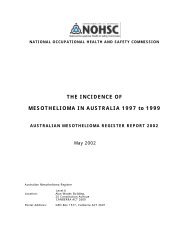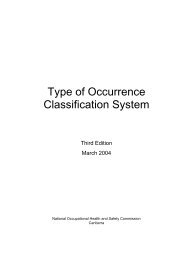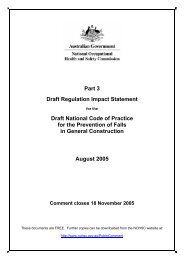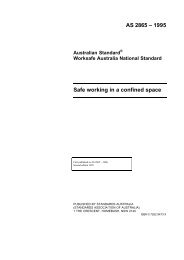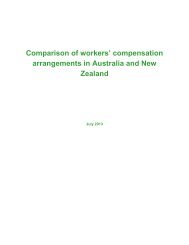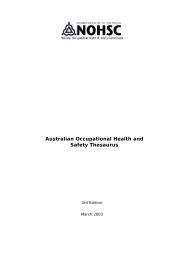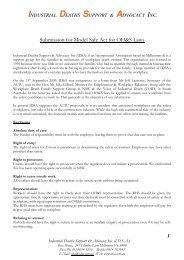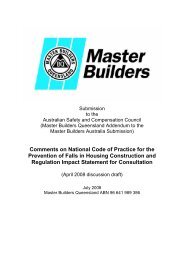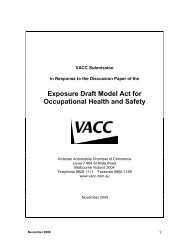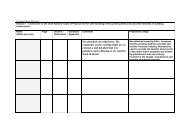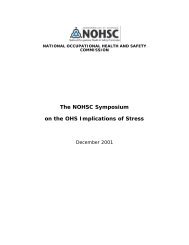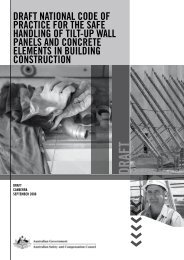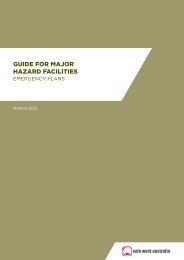Asbestos-related Disease Indicators.indd - Safe Work Australia
Asbestos-related Disease Indicators.indd - Safe Work Australia
Asbestos-related Disease Indicators.indd - Safe Work Australia
Create successful ePaper yourself
Turn your PDF publications into a flip-book with our unique Google optimized e-Paper software.
Introduction<strong>Asbestos</strong>-<strong>related</strong> diseases are responsible for an increasing number of deaths in<strong>Australia</strong>. In 2008, the most recent year covered by this publication, 628 deathsattributable to mesothelioma were registered, and 109 to asbestosis. The numberof deaths caused by lung cancer and other diseases possibly <strong>related</strong> to asbestosexposure is unknown.These deaths are the direct result of, in most cases, work-<strong>related</strong> exposure toasbestos fi bres up to 40 years ago. <strong>Asbestos</strong> is a mineral rock that is made up ofmasses of tiny fibres and occurs in a number of forms, three of which were usedcommercially in <strong>Australia</strong>. They are amosite, crocidolite and chrysotile.<strong>Asbestos</strong> was mined in <strong>Australia</strong> for over 100 years — ceasing by 1983. Thisdomestic production, combined with asbestos imports, gave rise to <strong>Australia</strong> havingthe world’s highest per-capita use of asbestos in the 1950s (Leigh et al, 2002). Thishigh rate of usage reflected the very useful thermal and mechanical properties ofthe material. These properties led to its extensive use in a multitude of domestic andindustrial products and, in particular, in fibre-cement products like pipes, wall panels,and roof sheeting. The use and importation of all forms of asbestos (with a few veryspecialised exceptions) was prohibited in <strong>Australia</strong> from December 2003.When asbestos is mined or processed, or when asbestos-based products aresanded, sawn or drilled, it can form a fi ne airborne dust made up of tiny fi bres.These fi bres are easily breathed in to the lung where they can become embedded.Due to the small size and elongated shape of the particles they can resist thelung’s natural cleaning process and may cause serious health problems in lateryears. In particular, the fi bres can work their way through the lung tissue and intothe pleura – the membrane that surrounds the lungs.Exposure to asbestos can cause respiratory diseases and cancers including:> lung cancer> mesothelioma, (pleural, peritoneal or pericardial)> asbestosis, and> some other cancers.Besides this report, <strong>Safe</strong> <strong>Work</strong> <strong>Australia</strong> has undertaken a number of initiatives tobetter monitor and improve the understanding of asbestos-<strong>related</strong> diseases.These include:> The publication of the Mesothelioma in <strong>Australia</strong> report: a detailedexamination of diagnosis and deaths data collected by cancer registries andthe <strong>Australia</strong>n Bureau of Statistics.> The establishment of the <strong>Australia</strong>n Mesothelioma Registry to replace the<strong>Australia</strong>n Mesothelioma Register which was suspended in 2008 becauseof the considerable reduction in the number of notifi cations under new stateprivacy laws. In 2010, <strong>Safe</strong> <strong>Work</strong> <strong>Australia</strong> contracted a consortium led bythe Cancer Institute of New South Wales to manage the new <strong>Australia</strong>nMesothelioma Registry which will combine the mandatory notifi cation ofmesothelioma to the cancer registries with timely follow up of consentingpatients to collect exposure information.> The instigation of a survey to examine exposure to asbestos amongconstruction workers and their attitudes, perceptions and behaviours <strong>related</strong>to asbestos (<strong>Asbestos</strong> Exposure and Compliance Study of Construction andMaintenance <strong>Work</strong>ers).<strong>Asbestos</strong>-<strong>related</strong> <strong>Disease</strong> <strong>Indicators</strong>, August 2010 ... vii



